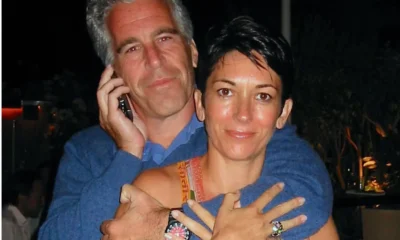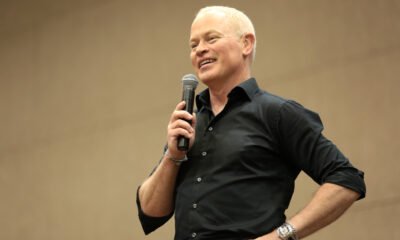Entertainment
Kendall Jenner Doesn’t Know What Knife to Use to Cut a Cake on November 9, 2023 at 5:00 am Us Weekly

Kendall Jenner Taylor Hill/Getty Images
Kendall Jenner still can’t keep up in the kitchen.
During a new episode of The Kardashians, which started streaming on Thursday, November 9, Kendall, 28, celebrated the birth of her new horse with a small party. Khloé Kardashian and Kris Jenner were in attendance as Kendall rang in the new arrival to her family.
It didn’t take longfor Kendall to run into a problem after blowing out the candle on her cake.
“Is this carrot cake? Because I actually want some,” she said before looking for a utensil. “What knife should I [use]? Like is this the proper knife? I don’t want to use the wrong thing to cut.”
Kris, 68, initially pointed out that Kendall grabbed “a spatula” instead of a knife. Khloé, 39, corrected both her mother and sister, saying, “That’s an icing tool. That’s how you ice a cake.”
Kendall quickly ran into a new problem after selecting a knife. “That was harder to cut than it should have been,” she noted. “What did I do wrong guys? It won’t come out. Oh, I was picking it up too low.”
Khloé joked about Kendall’s culinary woes in a confessional, saying, “Kendall, clearly the kitchen is not your safe space. She’s not a good food cutter.”
Kendall’s skills in the kitchen have been a topic of conversation since season 1 of The Kardashians when she now-infamously cut a cucumber incorrectly.
“Watching it back, I was like, ‘Why did I cut it like that?’” she recalled during a press event in June 2022. “I literally was talking to one of her chefs and I was like, ‘Can you help me? Can you teach me? What did I do wrong? How can I do better? Let me take it seriously.’”
According to Khloé, Kendall was actually upset by how the scene blew up on social media.
“She’s, like, not happy [about the video]. I feel so — I’m like, ‘Kendall, God is fair,’” Khloé said on an episode of the “Not Skinny But Not Fat” podcast at the time. “You’re the most beautiful human being in the world. You have wild looking toes, God bless. And you can’t cut a f–king cucumber. The world is good because … how can you be this f–king perfect? She has the perfect life. You can’t cut a f–king cucumber? Please, come over and stay with me for one week. She’ll really cry herself a river. Oh, my God. But I’m going to teach her.”
Earlier this season, Kendall insisted she wasn’t bothered by the viral moment. “By the way guys, I cut that cucumber safely. For anyone who says I can’t cut a cucumber, it was sliced. It was cut. People really think it is a diss now,” she said in a September episode. “You think that you are offending me? Because you are not. Who gives a s—t?”
Kendall concluded: “If that’s the only bad thing you have to say about me then keep it going. That’s the last thing I will say about this f—king cucumber thing.”
New episodes of The Kardashians air on Hulu every Thursday.
Kendall Jenner still can’t keep up in the kitchen. During a new episode of The Kardashians, which started streaming on Thursday, November 9, Kendall, 28, celebrated the birth of her new horse with a small party. Khloé Kardashian and Kris Jenner were in attendance as Kendall rang in the new arrival to her family. It
Us Weekly Read More
Entertainment
What We Can Learn Inside 50 Cent’s Explosive Diddy Documentary: 5 Reasons You Should Watch

50 Cent’s new Netflix docuseries about Sean “Diddy” Combs is more than a headline-grabbing exposé; it is a meticulous breakdown of how power, celebrity, and silence can collide in the entertainment industry.
Across its episodes, the series traces Diddy’s rise, the allegations that followed him for years, and the shocking footage and testimonies now forcing a wider cultural reckoning.

1. It Chronicles Diddy’s Rise and Fall – And How Power Warps Reality
The docuseries follows Combs from hitmaker and business icon to a figure facing serious criminal conviction and public disgrace, mapping out decades of influence, branding, and behind-the-scenes behavior. Watching that arc shows how money, fame, and industry relationships can shield someone from scrutiny and delay accountability, even as disturbing accusations accumulate.

2. Never-Before-Seen Footage Shows How Narratives Are Managed
Exclusive footage of Diddy in private settings and in the tense days around his legal troubles reveals how carefully celebrity narratives are shaped, even in crisis.
Viewers can learn to question polished statements and recognize that what looks spontaneous in public is often the result of strategy, damage control, and legal calculation.
3. Survivors’ Stories Highlight Patterns of Abuse and Silence
Interviews with alleged victims, former staff, and industry insiders describe patterns of control, fear, and emotional or physical harm that were long whispered about but rarely aired in this detail. Their stories underline how difficult it is to speak out against a powerful figure, teaching viewers why many survivors delay disclosure and why consistent patterns across multiple accounts matter.
4. 50 Cent’s Approach Shows Storytelling as a Tool for Accountability
As executive producer, 50 Cent uses his reputation and platform to push a project that leans into uncomfortable truths rather than protecting industry relationships. The series demonstrates how documentary storytelling can challenge established power structures, elevate marginalized voices, and pressure institutions to respond when traditional systems have failed.
5. The Cultural Backlash Reveals How Society Handles Celebrity Accountability
Reactions to the doc—ranging from people calling it necessary and brave to others dismissing it as a vendetta or smear campaign—expose how emotionally invested audiences can be in defending or condemning a famous figure. Watching that debate unfold helps viewers see how fandom, nostalgia, and bias influence who is believed, and why conversations about “cancel culture” often mask deeper questions about justice and who is considered too powerful to fall.
Entertainment
South Park’s Christmas Episode Delivers the Antichrist

A new Christmas-themed episode of South Park is scheduled to air with a central plot in which Satan is depicted as preparing for the birth of an Antichrist figure. The premise extends a season-long narrative arc that has involved Satan, Donald Trump, and apocalyptic rhetoric, positioning this holiday episode as a culmination of those storylines rather than a stand‑alone concept.
Episode premise and season context
According to published synopses and entertainment coverage, the episode frames the Antichrist as part of a fictional storyline that blends religious symbolism with commentary on politics, media, and cultural fear. This follows earlier Season 28 episodes that introduced ideas about Trump fathering an Antichrist child and tech billionaire Peter Thiel obsessing over prophecy and end‑times narratives. The Christmas setting is presented as a contrast to the darker themes, reflecting the series’ pattern of pairing holiday imagery with controversial subject matter.
Public and political reactions
Coverage notes that some figures connected to Donald Trump’s political orbit have criticized the season’s portrayal of Trump and his allies, describing the show as relying on shock tactics rather than substantive critique. Commentators highlight that these objections are directed more at the depiction of real political figures and the show’s tone than at the specific theology of the Antichrist storyline.
At the time of reporting, there have not been widely reported, detailed statements from major religious leaders focused solely on this Christmas episode, though religion-focused criticism of South Park in general has a long history.
Media and cultural commentary
Entertainment outlets such as The Hollywood Reporter, Entertainment Weekly, Forbes, Slate, and USA Today describe the Antichrist arc as part of South Park’s ongoing use of Trump-era and tech-world politics as material for satire.
Viewer guidance and content advisory
South Park is rated TV‑MA and is intended for adult audiences due to strong language, explicit themes, and frequent use of religious and political satire. Viewers who are sensitive to depictions of Satan, the Antichrist, or parodies involving real political figures may find this episode particularly objectionable, while others may view it as consistent with the show’s long‑running approach to controversial topics. As with previous episodes, individual responses are likely to vary widely, and the episode is best understood as part of an ongoing satirical series rather than a factual or theological statement.
Entertainment
Sydney Sweeney Finally Confronts the Plastic Surgery Rumors

Sydney Sweeney has decided she is finished watching strangers on the internet treat her face like a forensic project. After years of side‑by‑side screenshots, “then vs now” TikToks, and long comment threads wondering what work she has supposedly had done, the actor is now addressing the plastic surgery rumors directly—and using them to say something larger about how women are looked at in Hollywood and online.

Growing Up on Camera vs. “Before and After” Culture
Sweeney points out that people are often mistaking normal changes for procedures: she grew up on camera, her roles now come with big‑budget glam teams, and her body has shifted as she has trained, aged, and worked nonstop. Yet every new red‑carpet photo gets folded into a narrative that assumes surgeons, not time, are responsible. Rather than walking through a checklist of what is “real,” she emphasizes how bizarre it is that internet detectives comb through pores, noses, and jawlines as if they are owed an explanation for every contour of a woman’s face.
The Real Problem Isn’t Her Face
By speaking up, Sweeney is redirecting the conversation away from her features and toward the culture that obsesses over them.
She argues that the real issue isn’t whether an actress has had work done, but why audiences feel so entitled to dissect her body as public property in the first place.
For her, the constant speculation is less about curiosity and more about control—another way to tell women what they should look like and punish them when they do not fit. In calling out that dynamic, Sweeney isn’t just defending herself; she is forcing fans and followers to ask why tearing apart someone else’s appearance has become such a popular form of entertainment.

 Entertainment2 weeks ago
Entertainment2 weeks agoWicked Sequel Disappoints Fans: Audience Verdict on For Good

 News3 weeks ago
News3 weeks agoYolanda Adams Questions Traditional Views on God’s Gender, Audience Reacts

 Entertainment2 weeks ago
Entertainment2 weeks agoAriana & Cynthia Say They’re in a ‘Non‑Demi Curious, Semi‑Binary’ Relationship… WTF Does That Even Mean?

 News3 weeks ago
News3 weeks agoEpstein Files to Be Declassified After Trump Order

 News4 weeks ago
News4 weeks agoTrump Throws Epstein Files at Clinton’s Door

 Entertainment4 weeks ago
Entertainment4 weeks agoAriana Grande’s Red Carpet: When Fans Forget Boundaries

 Entertainment3 weeks ago
Entertainment3 weeks agoHollywood’s Kiss or Miss Policy: Why Saying No Got Neal McDonough Blackballed

 Entertainment3 weeks ago
Entertainment3 weeks agoJimmy Cliff, Reggae Legend and Star of ‘The Harder They Come,’ Dies at 81



























e-commerce
March 10, 2024 at 3:47 am
Wow, wonderful blog structure! How long have you ever been blogging
for? you make blogging glance easy. The overall look of your website is fantastic, as neatly as the content material!
You can see similar here sklep online
sklep internetowy
March 12, 2024 at 10:24 pm
I used to be suggested this web site by way of my cousin. I
am no longer positive whether or not this submit is written via him
as no one else realize such unique about my problem.
You’re incredible! Thank you! I saw similar here: Najlepszy sklep
najlepszy sklep
March 14, 2024 at 2:35 pm
WOW just what I was searching for. Came here by searching for ecommerce
I saw similar here: Sklep online
e-commerce
March 24, 2024 at 1:03 pm
Hi there! Do you know if they make any plugins to assist
with Search Engine Optimization? I’m trying to get my blog to rank
for some targeted keywords but I’m not seeing very
good results. If you know of any please share.
Many thanks! You can read similar blog here: Ecommerce
Analytical and Research Agency
March 24, 2024 at 9:21 pm
It’s very interesting! If you need help, look here: ARA Agency